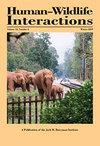Intake of Supplemental Deer Pellets Containing Ground Blueberry Juniper by Wild Pigs
IF 0.9
4区 环境科学与生态学
Q4 BIODIVERSITY CONSERVATION
引用次数: 0
Abstract
: Supplemental feeding of cervid species such as white-tailed deer ( Odocoileus virginianus ; deer) is now a common management practice in the United States. Supplemental feeding can be costly and more expensive when supplements are consumed by non-target species such as wild pigs ( Sus scrofa ; pigs). From May 13 to June 17, 2015, we evaluated the effects of using ground blueberry juniper ( Juniperus ashei) or cottonseed ( Gossypium spp.) hulls as a roughage ingredient in a supplemental deer pellet to deter pig consumption at the Texas A&M AgriLife Research Center in San Angelo, Texas, USA. We analyzed dry matter intake, growth performance, in vitro digestibility and fermentation, and blood serum chemistry of pigs using a 2 × 2 factorial study design that included 3 feeding periods. Pigs were assigned to 1 of 4 supplement diets ( n = 5 pigs/supplement) or to a commercially available swine diet (BASAL; n = 4 pigs). Animals assigned to supplement diets were also offered BASAL based on percentage of body weight (BW) during each period. Supplement diets differed by roughage source and percentage of roughage: cottonseed hulls 20%, cottonseed hulls 40%, blueberry juniper 20%, or blueberry juniper 40%. During each period, the amount of supplement and BASAL diet offered to animals assigned to a supplement was fed as a percentage of BW; period 1 (day 0 to 17) = 5% supplement diet and 5% BASAL diet, period 2 (day 18 to 26) = 5% supplement diet and 2% BASAL diet, period 3 (day 27 to 34) = 5% supplement diet and 5% BASAL diet. Animals assigned to only BASAL were offered the same amount of feed as a percent of BW as supplement animals during each period. We observed a roughage × period interaction ( P = 0.03) for supplement dry matter intake g/day and a roughage × period interaction ( P < 0.09) for total dry matter intake as a percentage of BW. No differences were observed within period. No other variables had percent roughage x period differences. Ground blueberry juniper was indigestible by pigs; the in vitro digestibility of dry matter and gross energy was <1%. Greater blood serum alanine aminotransferase ( P = 0.07) in pigs consuming experimental supplement diets suggested the possibility of liver damage. Our findings suggest that there does not appear to be a benefit of using ground juniper as a roughage source to reduce consumption of supplemental deer feed by pigs.野猪对添加蓝莓杜松粉鹿丸的摄取量
:白尾鹿(Odocoileus virginianus)等鹿科动物的补充饲料;鹿)现在在美国是一种普遍的管理做法。如果非目标物种,如野猪(Sus scrofa;猪)。2015年5月13日至6月17日,我们在美国德克萨斯州圣安吉洛的德克萨斯A&M农业生物研究中心评估了使用磨碎的蓝莓杜松(Juniperus ashei)或棉籽(Gossypium spp.)壳作为补充鹿丸的粗料成分的效果,以阻止猪的消费。采用2 × 2因子试验设计,包括3个饲喂期,分析猪的干物质采食量、生长性能、体外消化率和发酵率以及血清化学。猪被分配到4种补充日粮中的1种(n = 5头/组)或市售猪日粮(基础日粮;N = 4头猪)。各组补充饲粮均按体重百分比饲喂基础饲粮。补充饲料根据粗饲料来源和粗饲料百分比不同:棉籽皮20%,棉籽皮40%,蓝莓杜松20%,蓝莓杜松40%。在每一阶段,按体重百分比饲喂补给品和基础饲粮;第1期(第0 ~ 17天)= 5%补充饲粮和5%基础饲粮,第2期(第18 ~ 26天)= 5%补充饲粮和2%基础饲粮,第3期(第27 ~ 34天)= 5%补充饲粮和5%基础饲粮。各组只饲喂基础饲粮的动物,以其体重百分比作为补充饲料。饲粮干物质采食量g/d和总干物质采食量占体重的比例分别存在饲粮粗料与饲粮周期的交互作用(P = 0.03)和饲粮粗料与饲粮周期的交互作用(P < 0.09)。两组间无明显差异。其他变量没有粗x期差异百分比。猪不能消化磨碎的蓝莓杜松;干物质和总能的体外消化率<1%。饲喂试验饲粮的猪血清丙氨酸转氨酶升高(P = 0.07),提示肝损伤的可能性。我们的研究结果表明,使用杜松作为粗饲料来源来减少猪对鹿饲料的补充消耗似乎没有好处。
本文章由计算机程序翻译,如有差异,请以英文原文为准。
求助全文
约1分钟内获得全文
求助全文
来源期刊

Human–Wildlife Interactions
Environmental Science-Nature and Landscape Conservation
CiteScore
2.80
自引率
0.00%
发文量
0
审稿时长
11 weeks
期刊介绍:
Human–Wildlife Interactions (HWI) serves the professional needs of the wildlife biologist and manager in the arena of human–wildlife conflicts/interactions, wildlife damage management, and contemporary wildlife management. The intent of HWI is to publish original contributions on all aspects of contemporary wildlife management and human–wildlife interactions with an emphasis on scientific research and management case studies that identify and report innovative conservation strategies, technologies, tools, and partnerships that can enhance human–wildlife interactions by mitigating human–wildlife conflicts through direct and indirect management of wildlife and increased stakeholder engagement. Our intent is to promote a dialogue among wildlife professionals concerning contemporary management issues. As such, we hope to provide a repository for wildlife management science and case studies that document and share manager experiences and lessons learned.
 求助内容:
求助内容: 应助结果提醒方式:
应助结果提醒方式:


